Reader Tim Reinard in California asked to see a wider shot of Lino’s medals surrounding our barometer. Glad to oblige. These are only a few of the medals he has won or been awarded over the years as a Venetian rowing racer, or race judge, or participant in a number of major foreign boating events.
Acqua alta update
Watching the various weather signs yesterday morning as closely as a jungle tracker (or desert tracker, or suburban mother looking for a parking place at the mall), I realized fairly early that the Warnings which I was following were turning out to have been perhaps slightly excessive.
Caution is a superb thing and we should all have more of it, except for when we shouldn’t, I mean. But I have the sensation — and so does Lino — that a certain amount of exaggeration has crept into the whole business of predicting acqua alta. Why?
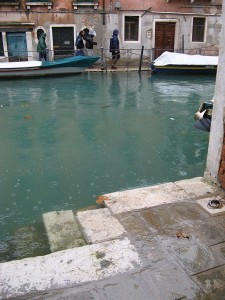
One reason, and I’m just hypothesizing here, could be that the people in the Tide Center (particularly its battle-hardened director, Paolo Canestrelli, who would feel perfectly at home with Field Marshal Montgomery) are up to here with the shrieking imprecations from people inconvenienced by a change in the situation from the earlier prediction to the reality suddenly underfoot.
As I have already noted, the weather picture can change. Get over it.
Another reason — here, let me move that firing-range target to the side and stand there in its place — could be the relentless need for the many forces involved in the MOSE project to instill public dread of water on the ground. Even brief articles in the Gazzettino which mention a (not “the,” but “a”) possibility of high water the following day don’t bear down too hard on the word “possibility.” They like the effect the words “acqua alta” have on people, if put in a way that makes it sound as if you need to head for the storm cellar.
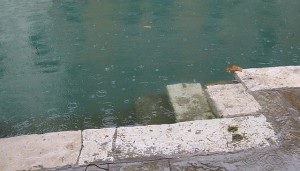
In any case, just remember that any article that you may read that implies, or even says, that “Venice was flooded” is a bit excessive. We didn’t get any water on our ground and we’re in Venice. Is San Marco’s high water better than ours? Prettier? Wetter?
If you have any interest in the damage water can seriously do to people, places and things, don’t get fixated on Venice, but look at other areas of the Veneto such as Vicenza and Verona, and even in Tuscany, over the past few days. Torrential rains, bursting riverbanks, highways and roads blocked and even broken by racing water, mudslides obliterating houses and the helpless people within them (like the mother and her two-year-old son whose bodies were dug out of their mud-filled house, still clinging to each other) — these are events involving water which deserve more publicity than they get.
Actually, “mudslide” is too innocuous a word for what happened in Tuscany after days of rain. Essentially a huge chunk of melting mountain just broke off and fell on this family’s house. Just like that. No warning sirens, no time to do anything except die. There are many families who have lost everything. Some people have drowned.
Parts of the Veneto have now been declared disaster areas. Venice was not on the list.
Waiting for acqua alta
I’m sitting here at 7:30 waiting to see what the water is going to do.
This is not the first time this fall that water has come ashore (as it probably will), but it’s the first time I’m taking it slightly more seriously — and by “seriously” I don’t mean I’m pulling the tarps off the lifeboats preparing to abandon ship, so to speak; I mean that I believe that the official prediction may be close to accurate. That alone would be worth writing about.
The accuracy is interesting only for the same reasons that any weather prediction is interesting — Did they get it right? And does this mean I should take future predictions really seriously?
There are several indications that they may be onto something this morning, most of which do not require their intervention because I have the tools at hand to understand and evaluate the probabilities all by my big-girl self.
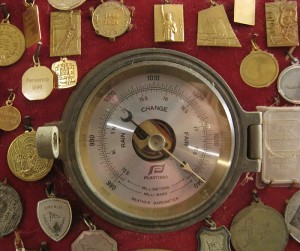
First, the barometric pressure. It has been impressively low for the last 12 hours, if not more. Low pressure means high water, a rule so simple even I can remember it.
Checking the barometer is one of the first useful things to do, and this is what impressive low pressure looks like. Note that whoever put those generic terms on the instrument’s face (“fair,” “change,” “rain”) didn’t consider putting “impressive high water” in the lower right-hand space. But that’s okay, because depending on where you live they would more usefully have had to put “monsoon,” “tropical cyclone” and other events not likely to occur here. So never mind.
Second, the wind direction. The garbin (gar-BEAN) was blowing strongly from the southwest yesterday afternoon, which is good because it impels the water to move northeast, or out into the Adriatic where it can do whatever the heck it wants to. Then it veered around to the north — even better.
But now it has veered to a scirocco, or southeast wind, which has the opposite effect of pressing the water into the lagoon, as I rustically think of it — or at least of creating enough force to block the tide’s normal retreat.
Third, we are now on the verge of the 24-hour period of the “morto de aqua,” or “death of the water,” when the tidal variation is minimal. This 24-hour period falls twice a month and doesn’t particularly influence the height of the high tide, but it does mean that since the tides are not especially strong, the weather is almost always unstable. Which means don’t count on anything except some kind of unpleasant weather. In the summer we can get huge thunderstorms during the “morto de aqua.”
If I had a shop near the Piazza San Marco and didn’t know any of the above, instead of wailing to the city about paying me for the damage or inconvenience I had suffered, I ought to be paying them for my preposterous ignorance. Hm — that would be an entertaining project: Setting a scale of penalty payments for preposterous ignorance. The mind absolutely sparkles at the thought.
Fourth, if you don’t know any of the above three basic facts of life in the lagoon, you can decide to depend on the city’s system of warning sirens, which sound an hour before water is expected to start rising through the drain system. If you live more than an hour away from San Marco, of course, this system doesn’t do you much good.
Or you might go online and consult the prediction from the city’s Centro Maree, or Tide Center.
It’s interesting to see the variation between the normal tidal flux (the lower, light red line) and the real-time prediction (upper blue line). The only problem with this tool is that its usefulness depends heavily on being updated in a timely fashion.
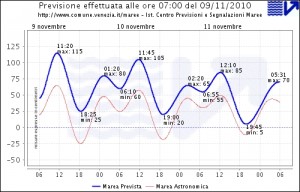
Really timely updates are available through the text-messaging system. However, if you have signed up with the Tide Center to get the prediction via your cell phone, you still might want to consider a fall-back position. A few days ago the Gazzettino reported that thousands of users had indeed received the necessary warning, but only several hours too late. The city blamed the mobile phone company and its incapacity to send thousands of simultaneous text messages. (Oh good — something even less dependable than weather predictions: cell phone efficiency). The city has since — they say — changed companies.
I have not signed up with this service because, well, we’ve got the barometer, which is incapable of lying and doesn’t depend on any human agent whatsoever. What a scintillating thought that is.
Update: The sirens have just sounded. And instead of the two tones which “code orange” would require, there was only one tone, meaning the maximum ought to be a mere 110 cm (43 inches)above normal sea level, not the earlier prediction of 115 cm (45 inches). This doesn’t mean they were wrong, it just means that something changed. Whatever it was, I’m for it. Two inches makes an inordinate amount of difference..
Armistice Day in Venice
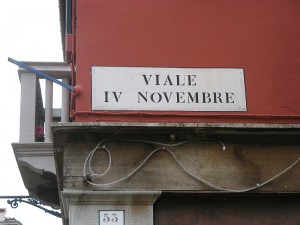
At 3:00 PM on November 4, 1918, peace returned to Italy. After 41 months of brutal battles on the Eastern Front, Italy and its allies had defeated the Austro-Hungarian Empire.
The Armistice of Villa Giusti had been signed the previous day by representatives of the Italian and Austro-Hungarian governments at a country house outside Padova, and it stipulated the precise moment at which hostilities were to cease. It sounds so elegant — “cease hostilities” — so much more imposing than saying “No more blowing millions of young men to splinters and shreds.”

The armistice between France and Germany which ended the War on the Western Front was signed in Compiegne, France on November 11. I remember commemorating Armistice Day on that date, before it was transformed into Veterans Day (decreed on June 1, 1954). In Italy, November 4 is observed as the Day of National Unity and the Armed Forces. Meaningful, but not poetic at all.
Of course I’m in favor of honoring everyone in uniform, but labels that are so generic muffle the profound resonance the end of the Great War, or as it’s sometimes called here, “The War of Fifteen-Eighteen,” had — and I believe still has — in European culture and history.
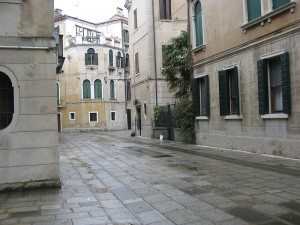
In Venice, part of the war’s aftermath was the construction of housing for veterans on a large swathe of empty land on the island known as Sant’ Elena at the easternmost end of Venice. It has always seemed a fairly bleak area to me (especially on one of those dark, foggy winter evenings).
But what the neighborhood may lack in charm it more than compensates for in the echoes still reverberating through the names of its streets — names of battles or battlefields, or generals, or dates so crucial that they need no explanation whatever to anyone in Italy. And certainly not to the families moving in.
Lest anyone imagine that Venice might have escaped any effects of the war, let me note that the city was bombed by the Austrians more than once. Buildings were damaged, and so were many of their inhabitants.
Campo Santa Giustina after the bombardment on February 26, 1918.

At 10:15 this morning, the flags were raised in the Piazza San Marco. Maybe a hundred tourists stopped to watch the half-hour ceremony, performed by detachments of the Army, Navy, and Carabinieri. The Prefect reviewed this modest array, some recorded band music was played (the Hymn of San Marco, and the national anthem), and letters from the President and the Minister of Defense were read. The veterans marched in and marched out.
And the flags were raised — Italian, European, and Venetian.
It was not very impressive. But in a way, it didn’t need to be. All anyone had to do to be impressed was to stop for 17 seconds and try to grasp what the ceremony represented. I’ve never been able to come close to grasping it, but I try.
The text of the “Bulletin of Victory,” issued by General Armando Diaz, supreme commander of the Italian army, is cast in the form of a bronze plaque made of melted enemy artillery, and is displayed in every City Hall and barracks in Italy. Here is the text (translated by me):
SUPREME COMMAND, 4 November 1918, 12 o’clock
The war against Austria-Hungary which, under the high command of His Majesty the King, the Italian Army, inferior in numbers and means, initiated on May 24, 1915, and with unwavering and tenacious valor conducted fiercely without interruption for 41 months, is won.
The gigantic battle engaged on the 24th of last October and in which took part 51 Italian divisions, three British, two French, one Czechoslovakian, and one American regiment, against 73 Austro-Hungarian divisions, is finished.
The rapid and daring advance of the XXIX Army Corps on Trento, blocking the enemy’s means of retreat in Trentino, overwhelming them on the west by the troops of the VII Army and on the east by those of the I, VI, and IV, determined yesterday the total ruin of the adversary’s front. From Brenta al Torre the irresistible surge of the XII, the VIII, and the X Army, and of the cavalry divisions, drove the fleeing enemy even further back.
On the plains, His Royal Highness the Duke of Aosta rapidly advanced at the head of his undefeated III Army, longing to return to the positions which they had already victoriously conquered and had never lost.
The Austro-Hungarian Army is annihilated; it suffered grave losses in the fierce resistance of the first days and in the pursuit it has lost huge quantities of materiel of every sort and virtually all of its stores and warehouses. It has left in our hands about 300,000 prisoners with entire general staffs and not less than 5,000 cannon.
The remains of what once was one of the most powerful armies in the world is ascending, hopelessly and in disorder, the valleys which it had descended with such proud security. DIAZ




